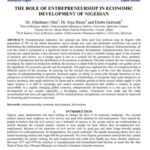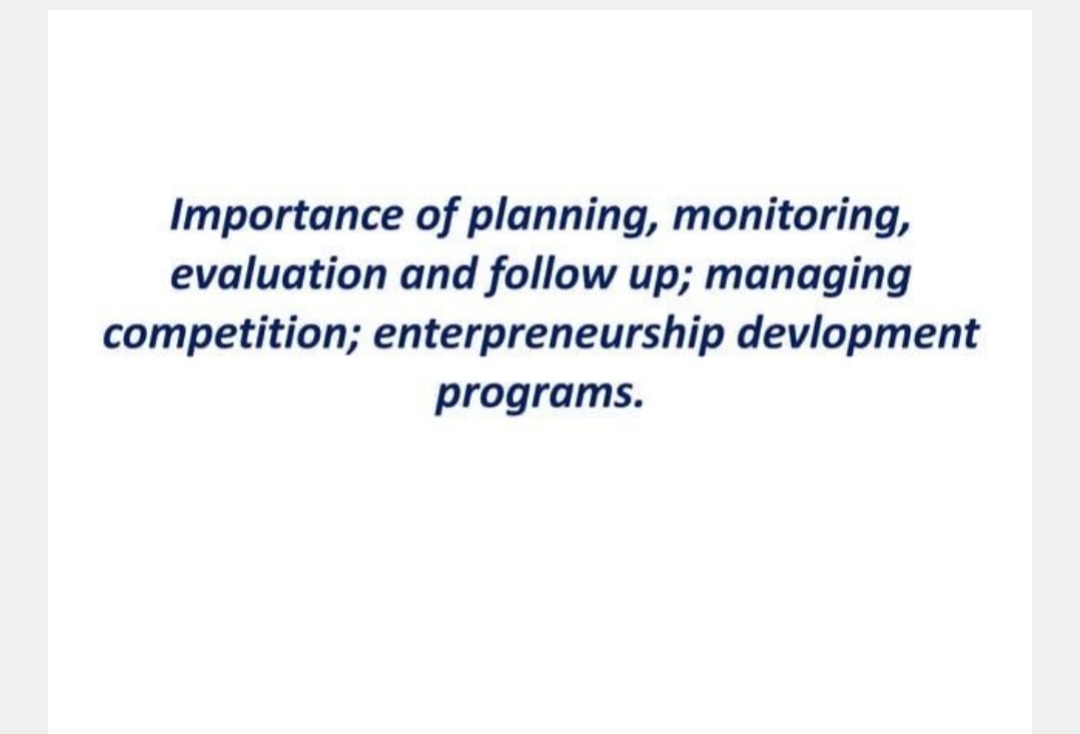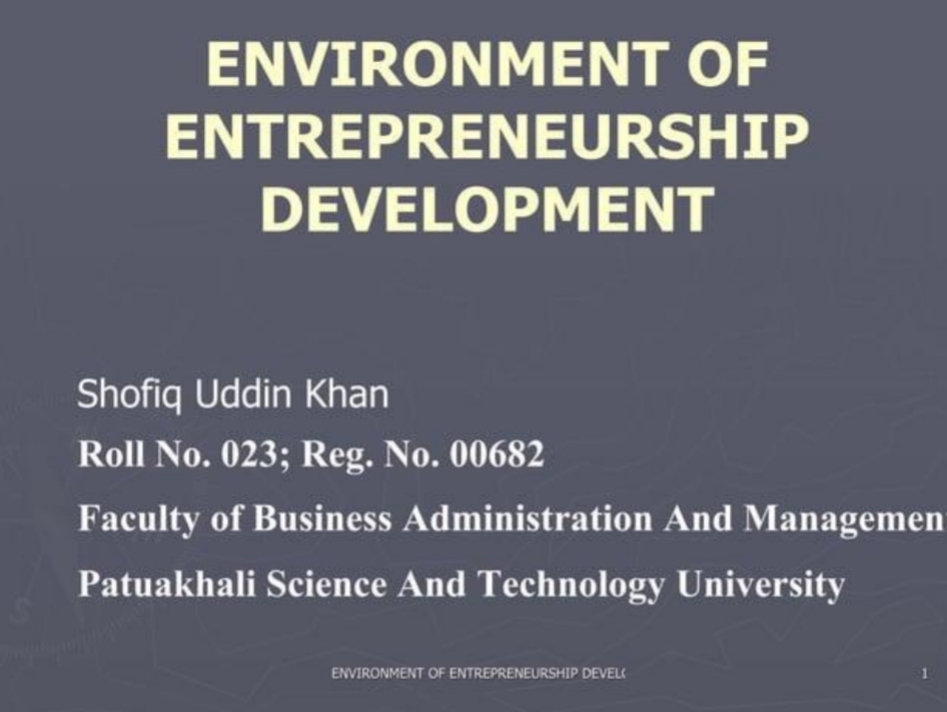Entrepreneurship Development – 1 PPT – Presentation on Entrepreneurship
- UNIT II ENTREPRENEUR
- Introduction Word derived from French word- ‘Entrprendre’ meaning to undertake Generally, entrepreneur refers to a person who establishes his won business. First used in 16th Century for the Frenchmen who undertake the military expeditions Richard Cantillon refers Entrepreneur As risk taking function
- Definition Richard Cantillon:- “ Entrepreneurs are non-fixed income earners who pay known of production but earn uncertain income” Jean-Baptiste Say:- “An Entrepreneur is an economic agent who units all means of production. Land of one, the labor of another and the capital of yet another and thus produces a product. By selling the product in the market, he pays rent of land, wages to the labor, intrest on capital and what remains is his profit . He shifts the economic resources out of an area of lower and into an area of higher productivity and greater yield.”
- Characteristics Of an Entrepreneur 1) Hard Work 2) Business acumen and sincerity 3) Prudence 4) Achievement motivation 5) Self-reliance and independence 6) Highly optimistic 7) Keen foresight
- Characteristics of an Entrepreneur 8) Planning & organizing ability 9) Innovativeness 10) Risk taking 11) Secrecy maintenance 12) Communication skills
- Qualities of an Entrepreneur 1) Motivating towards achievement 2) Creativity 3) Clarity 4) Energetic, Hardworking, Resourceful 5) Aware of New Opportunity 6) Handling Uncertainty 7) Interested in advance technology
- Qualities of an Entrepreneur 8) Interested in expanding Business 9) Visualizes Changes and adopts 10) Planning & Systematic work 11) Social Responsibility
- Types of Entrepreneur 1) Innovative Entrepreneur 2) Adoptive Entrepreneur 3) Fabian Entrepreneur 4) Drone Entrepreneur
- 1. Innovative Entrepreneur Highly motivated & talented Innovation is the key function Introduction of new product Introduction of new quality of existing product New method of production Opening a new market Discovering new source of supply of raw material or semi-finished goods Achieve monopoly or breakup monopoly
- 2. Adoptive or Imitative Entrepreneur Adopt the successful innovations Doesn’t innovate anything Imitates the techniques and technology of innovating entrepreneur
- 3. Fabian Entrepreneur Generally doubtful in nature Adopt great caution & skepticism Nighters the will to introduce any new changes nor to adopt new methods Imitate only when business seems to be profitable Dominated by customs, religions, traditions and past practices Not ready to take any risk
- 4. Drone Entrepreneur Blindly follows the traditional methods of production even it causes loss to him Not prepared to introduce any change under any circumstances in the method of production he has already introduced Carry Business in traditional way- loss For Ex. Coir Industry in Kerala dominated by Drone Entrepreneur
- Types of Entrepreneur According to Type of Business 1) Trading Entrepreneur 2) Industrial Entrepreneur 3) Corporate Entrepreneur 4) Agriculture Entrepreneur
- Some Other Type of Entrepreneurs 1) Born & Made Entrepreneurs 2) Educated & Uneducated Entrepreneurs 3) Rich & Poor Entrepreneur 4) Urban & Rural Entrepreneur 5) Collective & Individual Entrepreneur
- Factors Affecting Entrepreneurship Growth A) Economic Factors B) Social Factors C) Social Factors D) Personality Factors E) Psychological & Sociological Factors
- A) Economic Factors 1) Lack of adequate basic facility 2) Non-availability of capital 3) Non-availability of Raw Material & Finished Goods 4) Greater risk involved in Business 5) Non-availability of skilled labour
- B) Social Factors 1) Customers & traditions 2) Rationality of the society 3) Social system 4) Social setup
- C) Cultural Factors
- D) Personality Factors 1) Suspect personality 2) Emergence of planning
- E) Psychological & Sociological Factors
- Factors Promoting Entrepreneurship 1) Capital Formation :- Making Capital available to entrepreneurs to start new business 2) Entrepreneurship Development Programmes:- Supportive Government Programmes to develop entrepreneurship 3) Training Facilities :- Availability of adequate training facilities to promote and develop entrepreneurship
- Factors Promoting Entrepreneurship 4) Suitable Environment:- To transform scientific and technical developments into economically viable projects 5) Collateral Arrangement:- To establish a cordial relationship between business and research and for easy transferability of technology to the market place 6) Ideal Climate for innovations:- To promote & develop entrepreneurial activities
- Functions of Entrepreneurship 1) Planning to establish enterprise 2) Establish the enterprise 3) Operate enterprise 4) Control and evaluate the performance of the enterprise 5) Expand and develop enterprise
- 1. Planning to establish enterprise Identify the ideas for establishing the enterprise Analyze the idea Craft vision of the enterprise Set goals/objectives of the enterprise Conduct market survey and customer survey Calculate cost benefit ratio Identify the training needs of employees and training organizations Identify the sources of incentives
- 1. Planning to establish enterprise Identify and analyze the stakeholders Design processes Select site of the enterprise Prepare project report Apply for permissions to various regulatory bodies
- 2. Establish the enterprise Carry out preparation of site and construction work Design processes of production Purchase raw material Recruit professionals and employees Impart training Develop organizational structure, roles and responsibilities, authority and duty charts
- 3. Operate enterprise Implement the production activities Check quality of products Launch the product in the market Transport the product in the market To collect orders for purchase on regular basis Receive feedback from customers Solve problems of customers
- 3. Operate enterprise Remove complaint of the customers and stakeholders Expand products and services Motivates & encourage employees Reward the employees
- 4. Control and evaluate the performance of the enterprise Assess the effectiveness and efficiency of the enterprise Assess the profit Assess the turn over Assess the efficiency of various processes Assess the level of satisfaction of the customers Assess the level of wastage
- 5. Expand and develop enterprise Explore the opportunities for growth and development Analyze the opportunities Explore new markets Introduce product expansion, production increase, services increase, wastage reduction strategies Enter in new ventures
- Thank you, very much! Prof.Gholkar D.R. Assistant Professor Department of Commerce Deogiri College, Aurangabad
How to Get PPT
For Desktop/Laptop
- Scroll to the bottom of this page
- Click on the GET PPT button
- The download will automatically start
For Mobile devices
- Scroll to the bottom of this page
- Click on the GET PPT button
- The download will automatically start
- If the pop-up window opens in google drive/google slides
- Manually click on the download option to download the PPT
How to complete captcha (if required)
- Select all the possible captcha variations, skip if the none matches
- Scroll a bit and click on verify/skip
- The PPT will appear
Latest Job notifications across India: CLICK HERE
Latest Admissions: CLICK HERE
Latest Answer Keys of various exams conducted across India: CLICK HERE
Latest Results: CLICK HERE
Latest Admit Cards: CLICK HERE
Latest Syllabus: CLICK HERE
Sarkari Results, Job Notifications, Exam Results, Admit Cards: HERE















